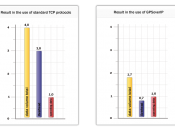Huffman Trucking was founded in 1936. Mr. Huffman started his business with a single tractor trailer and is now a national transportation company. Huffman Trucking continued to grow from internal sales and of five Eastern regional carriers. The company's corporate offices and service center is located in Cleveland, Ohio and has three hubs located in Los Angeles, California, St. Louis, Missouri, and Bayonne, New Jersey. Installed at each location are various telephony systems that handle the communication needs of the company. The purpose of this paper is to identify the telecommunication ports utilized by Huffman Trucking. Currently there are two communications industry leaders: Transmission Control Protocol/Internet Protocol (TCP/IP), Internetwork Packet Exchange/Sequenced Packet Exchange (IPX/SPX), and Simple Mail Transfer Protocol (SMTP). Currently Huffman employs all three of these protocols in their enterprise.
TCP/IPTransmission Control Protocol/Internet Protocol, also known as TCP/IP, is the most common network protocol used today. It is the basic communication protocol of the Internet.
This type of protocol is not only used for Internet purposes but it is also widely used by private networks (intranet and extranet web pages). Huffman Trucking currently has internet and extranet web pages. Their internet webpage is used by their customers or their future prospective customers. In the other part they also use intranet. An intranet is a private network that is contained within an organization. Since Huffman has offices all around the United States all locations can access the same intranet through firewall servers. This gives the company the ability to view the same intranet while the company's security is maintained. The TCP/IP is known to be a two-layer program. The TCP manage the assembling of a message into smaller packets that are transmitted over the Internet and received by a TCP layer that reassembles the packets into the original...


